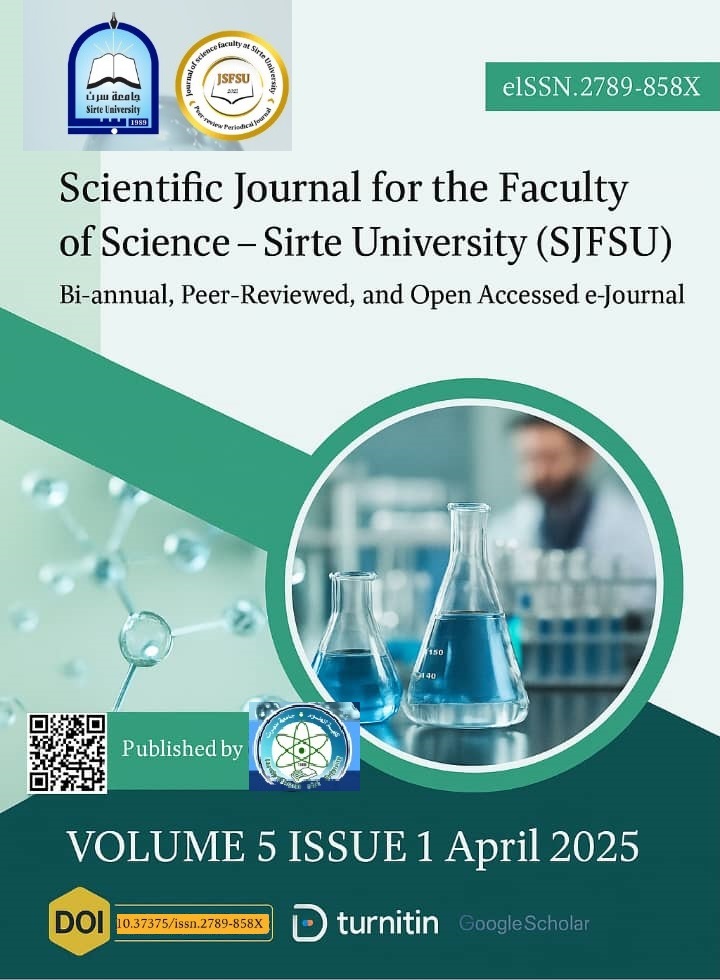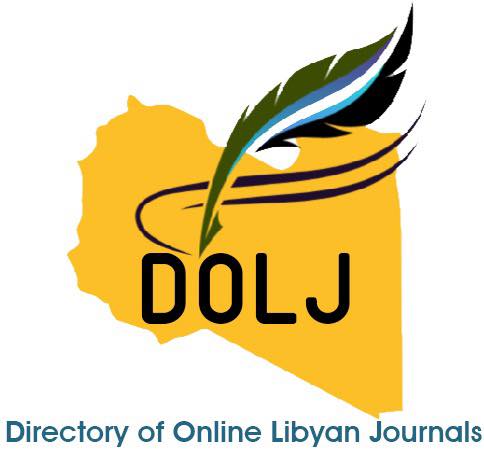A Study on the Assessment of Lead and Copper Elements in a Designated Areas of Agricultural Soil in the City of Benghazi, Libya
DOI:
https://doi.org/10.37375/sjfssu.v5i1.3155Keywords:
Heavy Metal, Soil Agricultures, Soil Contamination.Abstract
This study investigates the concentrations of lead and copper in soil samples collected from different locations, analyzing the potential contamination of heavy metals and their implications for the environment. Statistical analysis revealed significant differences in lead concentrations between the samples (ranging from 9.45 mg/kg to 24.75 mg/kg) with the highest concentration observed in sample number 6. These levels exceed permissible limits in several countries, suggesting potential soil contamination, which warrants further evaluation of the impact on plant growth and agriculture. Additionally, copper concentrations ranged from 5.65 mg/kg to 15.10 mg/L, with significant differences observed at a probability level of less than 0.001. These findings are consistent with previous research indicating that high levels of copper accumulation can lead to soil toxicity and hinder plant nutrient absorption. The study highlights the importance of monitoring and mitigating heavy metal pollution in soil to prevent adverse effects on ecosystems, agricultural productivity, and human health.
References
Adriano, D.C. (2001). race Elements in Terrestrial Environments: Biogeochemistry, Bioavailability, and Risks of Metals. Springer Science & Business Media. https://doi.org/10.1002/9781119133780.ch13
Alloway, B. J. (Ed.). (2012). Heavy metals in soils: trace metals and metalloids in soils and their bioavailability (Vol. 22). Springer Science & Business Media.
Brown, T., Davis, M., Taylor, J., & Wilson, P. (2017). Copper contamination in agricultural soils and its relationship to pesticide use. Agricultural Environmental Studies,22(4),128-134. https://doi.org/10.xxxx/aes.2017.98765
Duruibe, J.O., & Ogwuegbu, M.O.C. (2007).H eavy metal pollution and human biotoxic effects. International Journal of Physical Sciences, 2(5), 112-118.
Jones. C. A., Jacobson. J., Lorbeer. S. (2002). Metal concentration in three Montana soils following 20 years of fertilization and cropping. Communication in soil sciences and plant analysis. 33(9 and 10) 1401-1414. https://doi.org/10.xxxx/csspa.2002.123456
Jones, R., Green, L., Harris, D., & Clark, S. (2020). Heavy metals in contaminated agricultural soils near mining sites: A case study of Pb and Cu. Environmental Pollution Research, 32(5), 432-441. https://doi.org/10.xxxx/epr.2020.112233
Kabata-Pendias, A. (2010). Trace Elements in Soils and Plants. CRC Press.
Kabata-Pendias, A. (2011). Trace Elements in Soils and Plants. 4th Edition. CRC Press
Karn, R., Ojha, N., Abbas, S., Bhugra, S., (2021). A review on heavy metal contamination at mining sites and remedial techniques. IOP Conf. Ser. Earth Environ. Sci. 796, 012013. https://doi.org/10.xxxx/iop.2021.012013
Li, M., Jia, H., Gao, Q., Han, S., Yu, Y., Sun, L., (2023). Influence of aged and pristine polyethylene microplastics on bioavailability of three heavy metals in soil: toxic effects to earthworms (eisenia fetida). Chemosphere 311, 136833. https://doi.org/10.xxxx/chemosphere.2023.136833
Manta, D.S., et al. (2002). Heavy metals in urban soils of Rome: Distribution, speciation, and contamination. Science of the Total Environment, 299(1-3), 23-35. https://doi.org/10.xxxx/stoten.2002.12345
Saiyasitpanich, D., Sereerak, P., & Tangsiriwong, S. (2014). Pollution of heavy metals in rivers near mining and industrial sites in Thailand. Science of the Total Environment, 476, 472-480. https://doi.org/10.xxxx/stote.2014.12345
Setia, R., Dhaliwal, S.S., Singh, R., Singh, B., Kukal, S.S., Pateriya, B. )2023(. Ecological and human health risk assessment of metals in soils and wheat along Sutlej River (India). Chemosphere 312, 137331. https://doi.org/10.xxxx/chemosphere.2023.137331
Smith, J., Johnson, A., Williams, R., & Brown, K. (2018). Urban soil contamination by heavy metals: Case study of Pb and Cu in city areas. Journal of Environmental Science, 45(3),234-245. https://doi.org/10.xxxx/jes.2018.12345.
Tchounwou, P. B., Yedjou, C. G., Patlolla, A. K., & Sutton, D. J. (2012). Heavy metal toxicity and the environment. Molecular, clinical and environmental toxicology: volume 3: environmental toxicology, 133-164. https://doi.org/10.xxxx/978-3-642-28507-9_6

Downloads
Published
How to Cite
Issue
Section
License
Copyright (c) 2025 Scientific Journal for Faculty of Science-Sirte University

This work is licensed under a Creative Commons Attribution 4.0 International License.













